烟草的起源与黄金叶品牌发展(英文版)
- 格式:ppt
- 大小:3.93 MB
- 文档页数:23

The History and Evolution of CigarettesCigarettes, a popular form of smoking, have a fascinating history that dates back to the 15th century. Originating in the Americas, they have since become a global phenomenon, shaping cultures and social habits across the world.Early forms of smoking were quite different from today's cigarettes. Tobacco was first introduced to Europe by Christopher Columbus in the 16th century, and it quickly became a fashionable vice among the upper classes. At this time, smoking was primarily done through pipes or cigars, which were made from rolled tobacco leaves.It was in the 19th century that cigarettes began to take their modern form. The invention of the cigarette-making machine in 1880 revolutionized the industry, allowing for the mass production of cigarettes. This, in turn, made smoking more accessible and affordable to the general population.The 20th century saw further advancements in cigarette technology. Filters were introduced to reduce the harshness of smoke, and new blends of tobacco were developed to create a smoother smoking experience. Marketing strategies also played a significant role in the widespread adoption of cigarettes, as companies targeted young smokers with catchy slogans and advertising campaigns.However, the rise of cigarettes also coincided with increasing health concerns. Studies began to emerge in the 20th century linking smoking to various health issues, including lung cancer and heart disease. This led to the implementation of smoking bans and restrictions in many countries, aiming to reduce the harm caused by cigarettes.Today, the cigarette industry faces numerous challenges. The rise of anti-smoking campaigns and awareness about the harmful effects of smoking has led to a decrease in smoking rates in many countries. Additionally, new products and alternatives to smoking, such as e-cigarettes and vaporizers, are gaining popularity among smokers looking for a healthier alternative.Despite these challenges, cigarettes remain a significant part of global culture and society. They continue to be a popular choice for smokers worldwide, despite the well-known health risks associated with them.香烟,作为一种流行的吸烟形式,拥有令人着迷的历史,可以追溯到15世纪。

一口气读懂烟草的前世今生(noli-me-tangere)包括狼疮和梅毒等时获得了奇效。
1535年出版的《印第安通史》---航海史学家裴南蒂斯·奥威图所著的,是这样记载的:“在其它的邪恶的习惯里,印第安人有种特别有害的嗜好便是去吸某一种烟以便产生不省人事的麻醉状态。
1558年航海水手们将烟草种子带回葡萄牙,随后传遍欧洲。
1560年前后,法国驻葡萄牙大使杰恩·尼古特(Jean Nicot)听说烟草能够解乏提神,可以止痛和治疗疾病,尤其对头痛有疗效,于是将烟草精心栽培在自己的花园里,经常采摘试吸,感觉良好。
尼古特还用烟草治好了厨师严重的刀伤,助手的父亲持续2年的腿部溃烂,妇女脸上的体癣,船长的瘰疬,用捣碎的烟草及汁液治愈了其助手面颊上的侵蚀性溃疡。
回到法国后,尼古特当听说法国有两位妇女患了一种无法可治的癌症,尼古特就将一些烟草送给了法兰西国王二世、王后的母亲及宫廷妇女。
鉴于尼古特的慷慨大方,烟草在当时被称为“大使草”或nicotiane。
后来人们为了纪念尼古特在烟草传播中的突出贡献,就把烟草中特有的植物碱——烟碱命名为尼古丁(nicotean)。
1612年,英国殖民官员约翰·罗尔夫在弗吉尼亚的詹姆斯镇大面积种植烟草,并开始做烟草贸易。
不过这要晚于哥伦布手下水手杰瑞兹。
1665年,英国伦敦鼠疫猖獗,不少人受瘟疫而丧命。
令人惊奇的是,那些吸烟者虽然频繁出入传染病患者的家中,或是多次参加病死者的葬礼,却安然无恙。
当鼠疫基本得到控制时,人们才恍然大悟,原来吸烟还具有一定的杀病毒作用。
因此,当时伦敦所有的公立学校,不论男女,都要强制学童在教室中吸烟以抵御瘟疫,违反此规定者还要受到处罚。
18世纪德国的一次霍乱大流行中,卷烟厂的5000名雪茄烟工人仅有8人得病,这表明吸烟对这种令人惧怕的霍乱具有一定的防疫作用。
第一次世界大战前,有位法国人调查了军人吸烟对传染性脑膜炎的预防作用,发现健康士兵中有94%是吸烟的,而已患该病的士兵中有75%是不吸烟或偶尔吸烟的,表明吸烟对预防脑膜炎具有一定的作用。
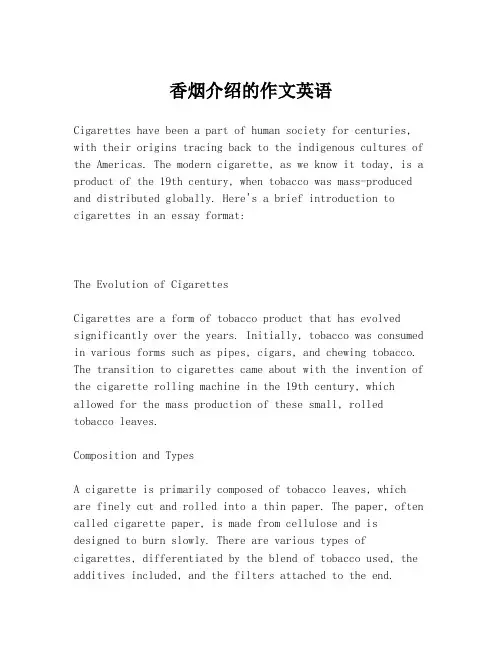
香烟介绍的作文英语Cigarettes have been a part of human society for centuries, with their origins tracing back to the indigenous cultures of the Americas. The modern cigarette, as we know it today, is a product of the 19th century, when tobacco was mass-produced and distributed globally. Here's a brief introduction to cigarettes in an essay format:The Evolution of CigarettesCigarettes are a form of tobacco product that has evolved significantly over the years. Initially, tobacco was consumed in various forms such as pipes, cigars, and chewing tobacco. The transition to cigarettes came about with the invention of the cigarette rolling machine in the 19th century, which allowed for the mass production of these small, rolled tobacco leaves.Composition and TypesA cigarette is primarily composed of tobacco leaves, which are finely cut and rolled into a thin paper. The paper, often called cigarette paper, is made from cellulose and is designed to burn slowly. There are various types of cigarettes, differentiated by the blend of tobacco used, the additives included, and the filters attached to the end.Manufacturing ProcessThe manufacturing process of cigarettes involves several stages. First, the tobacco leaves are cured, which can bedone through air curing, flue-curing, or sun curing. After curing, the leaves are fermented and then cut into fine shreds. The shreds are then blended with other ingredients to create the desired flavor and strength. The blend is thenrolled into a cigarette paper, and a filter is attached toone end.Health ConcernsDespite their popularity, cigarettes have been at the centerof health debates for decades. The combustion of tobacco in cigarettes releases a plethora of harmful chemicals,including nicotine, tar, and carbon monoxide. Thesesubstances have been linked to a range of health issues, most notably lung cancer, heart disease, and chronic obstructive pulmonary disease (COPD).Regulation and Public PerceptionIn recent years, there has been a significant push toregulate the sale and consumption of cigarettes due to their health risks. Many countries have implemented strict laws regarding the advertising of tobacco products, the sale to minors, and the display of health warnings on cigarette packs. Public perception has also shifted, with an increasing number of people choosing to quit smoking or never start.Future OutlookThe future of cigarettes is uncertain. With the rise of alternative nicotine products, such as e-cigarettes and nicotine replacement therapies, the demand for traditional cigarettes may decline. Additionally, stricter regulations and growing health awareness could lead to a further reduction in smoking rates.This essay provides a concise overview of cigarettes, touching upon their history, composition, manufacturing, health implications, and the current regulatory landscape.It's important to note that while cigarettes have been a part of culture and economy, they also pose significant risks to public health.。

烟草的起源与发展烟草是一种广泛使用的植物,其起源和发展历史相当悠久。
本文将详细介绍烟草的起源、传播和发展过程,以及其对人类社会的影响。
1. 烟草的起源烟草的起源可以追溯到几千年前的古代美洲。
根据考古学家的研究,烟草最早出现在现今的墨西哥和中美洲地区。
古代美洲人民将烟草用于宗教仪式、医疗和娱乐等方面。
2. 烟草的传播随着欧洲人的探险和殖民活动,烟草开始传播到其他地区。
哥伦布是第一个将烟草带回欧洲的探险家,他在1492年的第一次航行中发现了烟草。
很快,烟草就传播到了欧洲各地,并成为一种流行的商品。
3. 烟草的发展随着烟草的传播,种植烟草的需求也逐渐增加。
在殖民地时期,欧洲国家开始在自己的殖民地种植烟草,以满足对烟草的需求。
这导致了烟草种植业的快速发展,并成为一种重要的经济产业。
4. 烟草的品种和种植技术的改进随着时间的推移,人们开始培育不同品种的烟草,以满足不同消费者的需求。
通过选择和交配,人们培育出了高产量、高质量和耐病虫害的烟草品种。
同时,种植烟草的技术也得到了改进,包括土壤管理、病虫害控制和收割等方面。
5. 烟草的工业化生产和全球市场工业化生产使得烟草制品的生产规模大幅增加,烟草制品开始进入全球市场。
烟草制品的生产和销售成为许多国家的重要产业之一,为国家带来了巨大的经济收益。
同时,烟草制品也成为一种重要的国际贸易商品。
6. 烟草对健康的影响和控制措施烟草制品的吸烟对人体健康造成了严重的危害,包括肺癌、心血管疾病和呼吸系统疾病等。
为了应对这一问题,许多国家采取了各种措施来控制烟草的使用,包括烟草税、吸烟限制和健康教育等。
7. 烟草的未来发展趋势随着人们对健康的关注增加,烟草制品的消费量可能会逐渐下降。
同时,人们对替代烟草产品的需求也在增加,如电子烟和无烟烟草产品等。
这将对烟草产业产生重要的影响,并可能改变烟草产业的格局。
总结:烟草的起源可以追溯到古代美洲,随着欧洲人的探险和殖民活动,烟草开始传播到其他地区。

香烟的制造过程英文作文Title: The Manufacturing Process of Cigarettes。
Cigarettes, ubiquitous in today's society, undergo a complex manufacturing process before they find their way into the hands of consumers. From the cultivation of tobacco leaves to the final packaging, each step involves intricate procedures and specialized machinery. In this essay, we will delve into the detailed manufacturing process of cigarettes.1. Tobacco Cultivation: The journey of a cigarette begins with the cultivation of tobacco plants. Tobacco is primarily grown in regions with suitable climates and soil conditions. Farmers carefully tend to the plants, ensuring proper irrigation, fertilization, and pest control. Once mature, the leaves are harvested and prepared for the next stage.2. Curing and Fermentation: After harvesting, tobaccoleaves undergo curing and fermentation processes. Curing involves drying the leaves to reduce their moisture content and enhance flavor. Fermentation, on the other hand, is a controlled microbial process that further develops the flavor profile of the tobacco. These processes are crucial in determining the quality and characteristics of the final product.3. Blending and Flavoring: Next, the cured and fermented tobacco leaves are blended to achieve the desired taste and aroma. Different varieties of tobacco, each with its unique characteristics, are combined in precise proportions to create specific blends. Additionally, flavorings and additives may be introduced at this stage to enhance the sensory experience of the cigarettes.4. Cutting and Shredding: Once the tobacco blend is finalized, it undergoes cutting and shredding to achieve the appropriate texture and consistency. Specialized machinery is used to shred the leaves into fine strands, ensuring uniformity and consistency across batches.5. Formation of Tobacco Rods: The shredded tobacco is then fed into a machine that forms it into long continuous rods, which will later become the core of the cigarettes. This process involves compressing the tobacco tightly to ensure a consistent burn and draw.6. Wrapping in Paper: Simultaneously, paper is fed into another machine, where it is wrapped around the tobacco rods to form the cigarette tubes. The paper used for cigarette wrapping is specially designed to control the burn rate and stability of the cigarette.7. Filter Attachment: For filtered cigarettes, the next step involves attaching filters to one end of the cigarette tubes. Filters are typically made from cellulose acetate or other materials and serve to reduce the inhalation of smoke particles and harmful substances.8. Quality Control: Throughout the manufacturing process, rigorous quality control measures are implemented to ensure that each cigarette meets specified standards. Automated systems inspect factors such as weight, length,and density to identify any deviations from the desired parameters.9. Packing and Distribution: Once the cigarettes have passed quality control checks, they are packed into cartons or packs for distribution. Packaging may include additional branding, health warnings, and tax stamps as required by regulations in different regions. From there, thecigarettes are distributed to retailers for sale to consumers.In conclusion, the manufacturing process of cigarettes involves a series of carefully orchestrated steps, from the cultivation of tobacco plants to the final packaging of the finished product. Despite ongoing debates about the health risks associated with smoking, the production of cigarettes remains a highly regulated industry with strict quality control measures in place.。

关于香烟的历史与发展作文Cigarettes have a long and complex history, with their origins dating back thousands of years. Over time, theyhave evolved from a simple tobacco product to a global industry worth billions of dollars. This essay will explore the history and development of cigarettes from various perspectives, including their cultural significance, health implications, and economic impact.From a cultural perspective, cigarettes have played a significant role in societies around the world. The act of smoking has been deeply ingrained in various cultures,often associated with social activities, relaxation, and even rituals. For example, in many Middle Eastern countries, smoking hookah is a common practice during social gatherings. Similarly, smoking cigars has been associated with power and wealth in Western societies. The cultural significance of cigarettes can be seen in literature, art, and film, where smoking often symbolizes rebellion, sophistication, or even danger.However, the rise of scientific research in the 20th century shed light on the detrimental health effects of smoking. Smoking cigarettes has been linked to numerous health problems, including lung cancer, heart disease, and respiratory issues. The addictive nature of nicotine, a key component of cigarettes, makes it difficult for smokers to quit, further exacerbating the health risks. As a result, smoking has become a major public health concern, leading to the implementation of various anti-smoking campaigns, warning labels on cigarette packs, and even bans on smoking in public places in many countries.Despite the growing awareness of the health risks, the tobacco industry has continued to thrive economically. Cigarette companies have capitalized on the addictive nature of their products, creating a steady demand that spans across the globe. The economic impact of cigarettesis significant, with the industry generating billions of dollars in revenue each year. This has led to debates about the ethics of the tobacco industry and the role of governments in regulating and taxing tobacco products.In recent years, the rise of e-cigarettes and vaping has brought about a new chapter in the history of smoking. These electronic devices, often marketed as a safer alternative to traditional cigarettes, have gained popularity among smokers looking to quit or reduce their tobacco consumption. However, the long-term health effects of e-cigarettes are still not fully understood, and debates continue regarding their regulation and potential impact on youth smoking rates.In conclusion, the history and development ofcigarettes have been multifaceted, encompassing cultural, health, and economic perspectives. While cigarettes have played a significant role in various cultures, their health implications and addictive nature have raised concerns and led to efforts to reduce smoking rates. Despite these challenges, the tobacco industry remains a powerful economic force. The emergence of e-cigarettes further complicates the smoking landscape, highlighting the ongoing need for research, regulation, and public awareness surrounding smoking and its alternatives.。
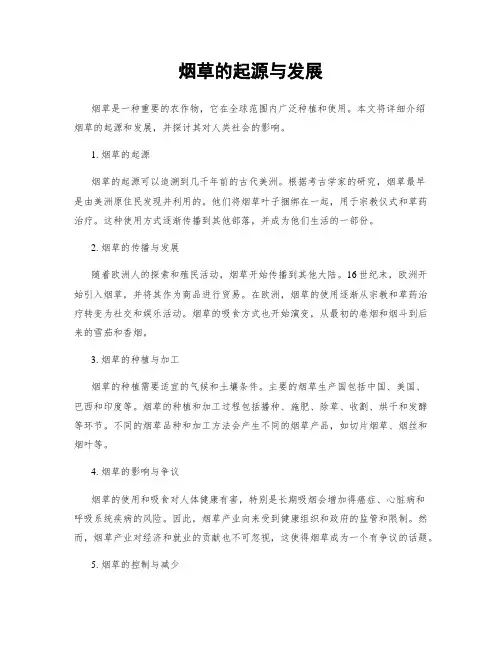
烟草的起源与发展烟草是一种重要的农作物,它在全球范围内广泛种植和使用。
本文将详细介绍烟草的起源和发展,并探讨其对人类社会的影响。
1. 烟草的起源烟草的起源可以追溯到几千年前的古代美洲。
根据考古学家的研究,烟草最早是由美洲原住民发现并利用的。
他们将烟草叶子捆绑在一起,用于宗教仪式和草药治疗。
这种使用方式逐渐传播到其他部落,并成为他们生活的一部份。
2. 烟草的传播与发展随着欧洲人的探索和殖民活动,烟草开始传播到其他大陆。
16世纪末,欧洲开始引入烟草,并将其作为商品进行贸易。
在欧洲,烟草的使用逐渐从宗教和草药治疗转变为社交和娱乐活动。
烟草的吸食方式也开始演变,从最初的卷烟和烟斗到后来的雪茄和香烟。
3. 烟草的种植与加工烟草的种植需要适宜的气候和土壤条件。
主要的烟草生产国包括中国、美国、巴西和印度等。
烟草的种植和加工过程包括播种、施肥、除草、收割、烘干和发酵等环节。
不同的烟草品种和加工方法会产生不同的烟草产品,如切片烟草、烟丝和烟叶等。
4. 烟草的影响与争议烟草的使用和吸食对人体健康有害,特别是长期吸烟会增加得癌症、心脏病和呼吸系统疾病的风险。
因此,烟草产业向来受到健康组织和政府的监管和限制。
然而,烟草产业对经济和就业的贡献也不可忽视,这使得烟草成为一个有争议的话题。
5. 烟草的控制与减少为了减少烟草对人体健康的危害,各国纷纷采取措施限制烟草的生产和销售。
这些措施包括加大对烟草的税收、禁止在公共场所吸烟、实施健康警示标签和推广戒烟计划等。
同时,一些替代品如电子烟也开始流行起来,作为吸烟的替代选择。
6. 烟草的未来发展趋势随着人们对健康的关注不断增加,烟草产业正面临着许多挑战。
然而,烟草仍然是一个巨大的市场,吸引着许多企业和投资者。
未来,烟草产业可能会趋向于生产更健康的烟草产品或者探索其他替代品,以适应市场需求的变化。
总结:烟草的起源与发展是一个复杂而有争议的话题。
它的起源可以追溯到几千年前的美洲原住民,经过欧洲人的传播和发展,成为全球广泛种植和使用的农作物。
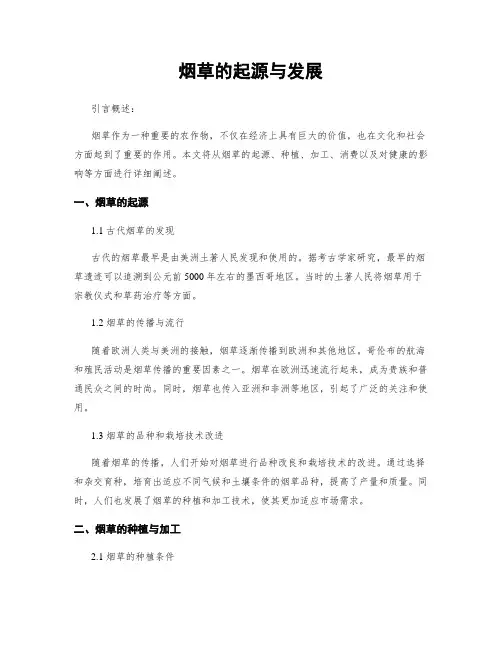
烟草的起源与发展引言概述:烟草作为一种重要的农作物,不仅在经济上具有巨大的价值,也在文化和社会方面起到了重要的作用。
本文将从烟草的起源、种植、加工、消费以及对健康的影响等方面进行详细阐述。
一、烟草的起源1.1 古代烟草的发现古代的烟草最早是由美洲土著人民发现和使用的。
据考古学家研究,最早的烟草遗迹可以追溯到公元前5000年左右的墨西哥地区。
当时的土著人民将烟草用于宗教仪式和草药治疗等方面。
1.2 烟草的传播与流行随着欧洲人类与美洲的接触,烟草逐渐传播到欧洲和其他地区。
哥伦布的航海和殖民活动是烟草传播的重要因素之一。
烟草在欧洲迅速流行起来,成为贵族和普通民众之间的时尚。
同时,烟草也传入亚洲和非洲等地区,引起了广泛的关注和使用。
1.3 烟草的品种和栽培技术改进随着烟草的传播,人们开始对烟草进行品种改良和栽培技术的改进。
通过选择和杂交育种,培育出适应不同气候和土壤条件的烟草品种,提高了产量和质量。
同时,人们也发展了烟草的种植和加工技术,使其更加适应市场需求。
二、烟草的种植与加工2.1 烟草的种植条件烟草的种植需要适宜的气候和土壤条件。
一般来说,烟草喜欢温暖而湿润的气候,对土壤要求较高,需要土质疏松、肥沃和排水良好的土地。
2.2 烟草的栽培技术烟草的栽培技术包括选地、翻耕、施肥、播种、灌溉、除草、病虫害防治等一系列措施。
其中,合理的施肥和灌溉是保证烟草生长和品质的重要因素。
2.3 烟草的加工过程烟草的加工过程包括采收、烘干、发酵、研磨和包装等环节。
采收后的烟叶需要经过烘干以去除水分,然后进行发酵和研磨等处理,最后按照不同的产品要求进行包装。
三、烟草的消费与市场3.1 烟草的消费形式烟草的消费形式主要包括吸烟、咀嚼和雪茄等。
吸烟是最常见的消费方式,通过燃烧烟草产生烟雾进行吸入。
咀嚼则是将烟草放入口中咀嚼,使其释放出香味和尼古丁。
雪茄是将烟草卷成长形雪茄状,通过点燃雪茄的一端进行吸烟。
3.2 烟草的市场规模和趋势烟草作为一种大宗商品,其市场规模巨大。

tobacco 翻译基本解释●tobacco:烟草●/təˈbækoʊ/●n. 烟草变化形式●n. 复数形式:tobaccos具体用法●n.:o烟草o例句:●Tobacco has been used by humans for centuries, and itscultivation has significantly impacted many cultures andeconomies around the world. (烟草被人类使用了几个世纪,其种植对世界上许多文化和经济产生了重大影响。
)●The tobacco industry is a major contributor to the economy,but it also poses significant health risks to consumers. (烟草行业是经济的重要贡献者,但它也对消费者构成了重大健康风险。
)●Many countries have implemented strict regulations ontobacco advertising to reduce its appeal to young people. (许多国家对烟草广告实施了严格的规定,以减少其对年轻人的吸引力。
)●Tobacco leaves are harvested and cured before beingprocessed into various products such as cigarettes and cigars.(烟草叶在加工成香烟和雪茄等各种产品之前会被收割和烘干。
)●The harmful effects of tobacco use are well-documented,leading to numerous public health campaigns aimed at reducing smoking rates. (烟草使用的有害影响已被充分记录,导致了许多旨在降低吸烟率的公共健康运动。
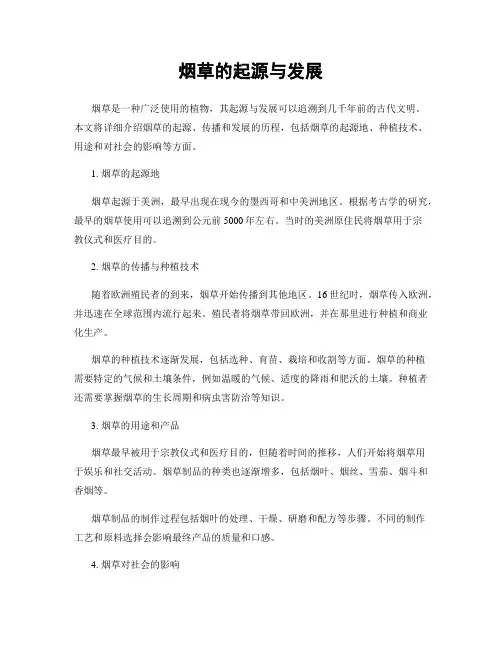
烟草的起源与发展烟草是一种广泛使用的植物,其起源与发展可以追溯到几千年前的古代文明。
本文将详细介绍烟草的起源、传播和发展的历程,包括烟草的起源地、种植技术、用途和对社会的影响等方面。
1. 烟草的起源地烟草起源于美洲,最早出现在现今的墨西哥和中美洲地区。
根据考古学的研究,最早的烟草使用可以追溯到公元前5000年左右。
当时的美洲原住民将烟草用于宗教仪式和医疗目的。
2. 烟草的传播与种植技术随着欧洲殖民者的到来,烟草开始传播到其他地区。
16世纪时,烟草传入欧洲,并迅速在全球范围内流行起来。
殖民者将烟草带回欧洲,并在那里进行种植和商业化生产。
烟草的种植技术逐渐发展,包括选种、育苗、栽培和收割等方面。
烟草的种植需要特定的气候和土壤条件,例如温暖的气候、适度的降雨和肥沃的土壤。
种植者还需要掌握烟草的生长周期和病虫害防治等知识。
3. 烟草的用途和产品烟草最早被用于宗教仪式和医疗目的,但随着时间的推移,人们开始将烟草用于娱乐和社交活动。
烟草制品的种类也逐渐增多,包括烟叶、烟丝、雪茄、烟斗和香烟等。
烟草制品的制作过程包括烟叶的处理、干燥、研磨和配方等步骤。
不同的制作工艺和原料选择会影响最终产品的质量和口感。
4. 烟草对社会的影响烟草在社会中产生了广泛的影响,既有正面的,也有负面的。
一方面,烟草成为了一种全球性的产业,为许多国家提供了就业机会和经济收入。
烟草还成为了一种文化和社交的象征,与特定的社会群体和活动相关联。
然而,烟草也带来了许多负面的影响。
烟草制品对健康有害,吸烟与许多疾病,尤其是肺癌和心血管疾病的发生有密切关系。
吸烟还对环境造成污染,烟草种植和制作过程产生的废弃物和化学物质对土壤和水源造成污染。
为了减少烟草对健康和环境的负面影响,许多国家采取了各种措施,包括加强对烟草制品的监管、提高税收、宣传健康教育和支持戒烟计划等。
总结:烟草的起源与发展是一个历史悠久且复杂的过程。
从最早的宗教仪式到现代的全球产业,烟草在人类社会中扮演了重要的角色。
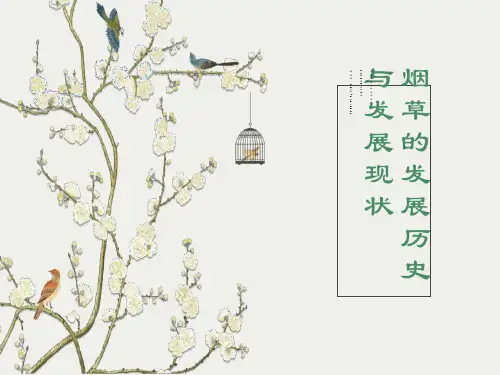
描述香烟产生以来的变化英语作文Cigarettes have undergone significant changes sincetheir inception. Here's a comprehensive overview of the evolution of cigarettes in English:Cigarettes have a long and complex history, dating back to the 16th century when tobacco was first introduced to Europe from the Americas. Initially, tobacco was consumed in the form of cigars, pipes, and snuff, but the development of the cigarette revolutionized the way people enjoyed tobacco.The earliest form of the modern cigarette emerged in the early 19th century, when the industrial revolution enabled the mass production of paper-wrapped tobacco rolls. These early cigarettes were often handmade and lacked the technological advancements that would come later.As the 19th century progressed, the cigarette industry began to evolve rapidly. The invention of the cigarette rolling machine in the 1880s allowed for the mass production of cigarettes, making them more affordable and accessible to the general public. This led to a surge incigarette consumption, as the convenience and affordability of these new products appealed to a growing number of consumers.The early 20th century saw further advancements in cigarette technology, with the introduction of filters and the development of various tobacco blends. Filters were initially designed to address concerns about the health effects of smoking, though their effectiveness in reducing harm was later called into question. Tobacco blending, on the other hand, allowed manufacturers to create unique flavor profiles and improve the overall smoking experience.The mid-20th century marked a significant turning point in the history of cigarettes. In the 1950s, scientific studies began to emerge that linked cigarette smoking to various health issues, including lung cancer and heart disease. This led to increased public awareness and a growing anti-smoking movement, which put significant pressure on the tobacco industry.In response, the industry began to employ varioustactics to maintain its market share and influence. This included the development of "low-tar" and "light"cigarettes, which were marketed as healthier alternatives, despite evidence that these products did not significantly reduce the health risks associated with smoking.The late 20th century and early 21st century have seen a continued evolution of the cigarette industry, with the introduction of electronic cigarettes and other alternative nicotine delivery systems. These products have been touted as less harmful than traditional cigarettes, though their long-term health effects are still being studied.Throughout this evolution, the cigarette industry has faced increasing regulation and public scrutiny. Governments around the world have implemented various policies, such as bans on smoking in public places, restrictions on advertising, and increased taxation, in an effort to curb the negative health and social impacts of cigarette smoking.As a result, cigarette consumption has declined in many parts of the world, particularly in developed countries. However, the industry continues to adapt and evolve, seeking new ways to maintain its market share and profitability.总的来说,香烟产品自诞生以来经历了巨大的变革。
香烟的变化英语作文Cigarettes have undergone a remarkable transformation over the past century, reflecting the evolving attitudes and regulations surrounding their use. From their humble beginnings as a symbol of sophistication and social status to their current stigmatized position, the journey of cigarettes has been marked by both cultural shifts and scientific advancements.In the early 20th century, cigarettes were often portrayed as a fashionable accessory, with celebrities and public figures openly endorsing their use. Advertisements during this era glamorized smoking, depicting it as a desirable and even aspirational behavior. Cigarettes were seen as a means of social bonding, with individuals gathering in designated smoking areas to engage in conversation and share a common experience.However, the tide began to turn as the health risks associated with smoking became more widely known. In the 1950s and 1960s, groundbreaking studies linked cigarette smoking to an increased risk of lung cancer and other respiratory diseases. This scientific evidence sparked a growing public awareness and a shift in societal perceptions of cigarettes.Governments around the world began to take action, implementing policies and regulations aimed at curbing the use of cigarettes. Bans on cigarette advertising, mandatory health warnings on packaging, and restrictions on public smoking all contributed to the gradual decline in cigarette consumption. The tobacco industry, once a powerful and influential force, found itself on the defensive as it struggled to maintain its market share and public image.The rise of alternative nicotine delivery systems, such as electronic cigarettes and vaping devices, further complicated the landscape of cigarette consumption. These products, marketed as a healthier alternative to traditional cigarettes, have gained significant popularity, particularly among younger generations. While the long-term health effects of these alternatives are still being studied, they have introduced a new dynamic to the ongoing debate surrounding the role of nicotine in society.Alongside the regulatory changes, the cultural perception of smoking has also undergone a dramatic transformation. Smoking is no longer seen as a symbol of sophistication or social status but rather as a harmful and socially unacceptable behavior. Public spaces, once dominated by the haze of cigarette smoke, have become increasingly smoke-free, with many establishments and workplaces implementing strict policies to protect the health and comfort oftheir patrons and employees.The shift in cultural attitudes has also been reflected in the media and entertainment industries. Depictions of smoking in movies, television shows, and other forms of popular culture have become less frequent and often carry a more negative connotation. Celebrities and public figures who once openly endorsed or participated in smoking have since distanced themselves from the practice, recognizing the growing social stigma associated with it.Despite these significant changes, the battle against cigarettes is far from over. The tobacco industry continues to adapt and find new ways to market its products, particularly in developing countries where regulations may be less stringent. Additionally, the rise of alternative nicotine delivery systems has introduced new challenges, as policymakers and public health officials grapple with the best ways to regulate these emerging technologies.In conclusion, the transformation of cigarettes over the past century has been a complex and multifaceted process, shaped by scientific discoveries, government regulations, and evolving cultural attitudes. As society continues to grapple with the ongoing challenges posed by nicotine addiction and the public health implications of smoking, it is clear that the story of cigarettes is far from over. The future of cigarettes will undoubtedly be shaped by the ongoing efforts topromote public health, protect individual rights, and balance the competing interests of various stakeholders.。
烟草的起源与发展烟叶生产和烟制品被人们吸用的历史相当悠久。
很早以前,人们便开始种植烟草。
作为野生的烟草,大约在两千多年前便被人们所认识,其特殊的气味和香气,对人类颇有吸引力。
烟草有一个美丽的英译别名,这就是人们常说的“淡巴菰”,它是从西班牙语“TobaccD”翻译而来的,现在世界上通用的也就是这个名字。
烟草的文字历史,最初出现在1492年10月12日,克里斯托弗·哥伦布抵达西印度群岛的圣隆尔瓦多海滩时,土著人拿来了水果,木矛以及散发着一种独特香气的“某种干叶片”。
以后,航海者发现烟草的利用在新大陆是相当普遍的。
从加拿大北部到巴西较低的边境地区的南美洲都在种植烟草,并以雪茄,卷烟,鼻烟和斗烟的形式在进行消费。
“烟草”这个词最初是当地土著人用以指吸食烟叶的烟管或烟斗。
1531年,西班牙人从墨西哥获得烟草种子,并在海地开始人工种植烟草,以后又扩大到附近其他岛屿。
1580年,古巴开始种植烟草,不久传入圭亚那和巴西,与此同时,烟草的种植,很快传到欧洲,亚洲和非洲。
据说,当时是由美国人把烟草种子带到欧洲,1556年,在法国种植,1558年到1559年,分别在葡萄牙,西班牙种植,1565年传入英国,到17世纪中叶,欧洲各国吸烟空气已相当盛行,并开始大量种植。
由于烟草生长的适应性很强,相继传到世界各地。
现在,烟草的种植已经遍及全世界近百个国家。
其中以中国,苏联,印度,中菲联邦等国产量较大。
我国种植烟草,大约始于16世纪中期,明朝万历年间,也就是1582年,意大利传教士利玛窦到京师,把烟草作为土特产,向中国皇帝贡献,使中国开始有了鼻烟。
明代名医张介宾著《景岳全书》中有记载“此物自古未闻也,近自明万历时始出于闽广之间,自后吴楚间皆种植矣。
”清朝同治八年(1869),会籍人赵之谦著《勇庐闲诘》载有“鼻烟来自大西洋意大里亚国,明万历九年利玛窦汛海入广东,旋至京师献万物,始通中国。
”当然,也还有两种说法:一种认为烟草从印度尼西亚,越南传入我国广东;另一种认为烟草从朝鲜传入我国东北,时间都在16世纪,品种都局限于晒烟。
介绍瓶装的香烟英语作文Title: The Elegance of Bottled Cigarettes。
In the realm of tobacco products, bottled cigarettes emerge as a refined embodiment of sophistication and convenience. This essay delves into the allure and practicality of bottled cigarettes, exploring their historical context, contemporary relevance, and the nuanced experience they offer to aficionados.Bottled cigarettes, an innovation in the tobacco industry, symbolize a fusion of tradition and modernity. Their origins can be traced back to the mid-20th century, when cigarette manufacturers sought to revolutionize packaging for enhanced portability and preservation. The concept was simple yet ingenious: encase a precise quantity of cigarettes within a sleek, compact bottle, ensuring freshness and protection from external elements. This innovation not only catered to the evolving lifestyles of consumers but also elevated the presentation of cigarettesto an art form.One cannot overlook the aesthetic appeal of bottled cigarettes. Encased within transparent or tinted glass, adorned with intricate designs or minimalist branding, these bottles exude an aura of sophistication. Whether displayed on shelves or carried in pockets, they serve as a testament to the discerning taste of their owners. Theritual of opening a bottle, akin to unveiling a treasure trove, adds a ceremonial aspect to the act of smoking, transforming it from a mundane habit into a moment of indulgence.Moreover, bottled cigarettes offer unparalleled convenience. Unlike traditional packs, which are susceptible to crushing and damage, bottles provide sturdy protection, ensuring that each cigarette emerges unscathed. This durability makes them ideal companions for travelers, urban dwellers, and outdoor enthusiasts who seek a reliable source of pleasure in any setting. Furthermore, the compact size of the bottles facilitates discreet storage, allowing smokers to enjoy their favorite blend without drawing undueattention.Beyond their practicality, bottled cigarettes offer a sensory experience that transcends ordinary smoking. Theact of removing a cigarette from its snug compartment, feeling the smooth texture of the paper between one's fingers, and inhaling the rich aroma of tobacco evokes a sense of anticipation and gratification. Each puff becomesa moment of contemplation, a brief respite from the hustle and bustle of everyday life. Moreover, the controlled quantity of cigarettes in each bottle encourages moderation, prompting smokers to savor each stick rather thanmindlessly consuming them.In contemporary society, where health concerns and regulations surrounding smoking continue to proliferate, bottled cigarettes occupy a unique niche. While they do not mitigate the inherent risks associated with tobacco consumption, they offer a more refined alternative for discerning smokers. By elevating the packaging and presentation of cigarettes, they challenge prevailing stereotypes and invite appreciation for the craftsmanshipand heritage behind this age-old indulgence.In conclusion, bottled cigarettes represent a convergence of elegance and utility in the realm of tobacco products. From their origins as a visionary packaging solution to their status as symbols of sophistication in modern society, they embody the timeless allure of smoking. As aficionados continue to seek moments of indulgence amidst the rigors of daily life, bottled cigarettes stand as a testament to the enduring appeal of this centuries-old tradition.。
关于香烟的英文作文Smoking is a habit that many people find hard to quit. It's a way to relieve stress and take a break from the hustle and bustle of life.The smell of smoke can be quite off-putting for non-smokers. It lingers on clothes and in the air, making it hard to escape.Some people believe that smoking helps them concentrate and stay focused. It's almost like a ritual for them, a way to gather their thoughts and clear their minds.The health risks of smoking are well-documented. It can lead to lung cancer, heart disease, and a whole host of other serious conditions. But for many, the addiction is too strong to overcome.There's something about the act of smoking that is almost romanticized in some cultures. It's seen as a symbolof rebellion and independence, a way to break free from societal norms.The tobacco industry is a powerful force, with millions of dollars spent on advertising and marketing. It's hard to escape the influence of these campaigns, especially for young people.Despite the known risks, many people continue to smoke. It's a hard habit to kick, and the allure of that nicotine hit is often too strong to resist.In the end, smoking is a personal choice. But it's important to weigh the risks and consider the impact it can have on your health and the health of those around you.。
介绍烟牌的作文400字英文回答:Smoking cigarettes has become an increasingly prevalent issue in modern society, with its detrimental effects on both individuals and communities.中文回答:香烟危害论述。
吸烟现象在现代社会中日益普遍,给个人和社会都带来了严重危害。
英文回答:The addictive nature of cigarettes, primarily due to the presence of nicotine, makes it challenging for smokers to quit. Nicotine acts on the brain's reward system, releasing dopamine and creating feelings of pleasure, thusreinforcing the habit.中文回答:卷烟的成瘾性很强,主要是因为其中含有尼古丁。
尼古丁作用于大脑的奖赏机制,释放多巴胺,从而产生愉悦感,让人对吸烟行为产生依赖。
英文回答:Health risks associated with smoking are numerous and severe. These include an increased risk of various types of cancer, cardiovascular diseases, respiratory diseases, and other chronic illnesses. Passive smoking, or secondhand smoke exposure, also poses significant health concerns, particularly for children and individuals with respiratory conditions.中文回答:吸烟会造成多种严重的健康危害,包括提高患各类癌症、心血管疾病、呼吸系统疾病和其他慢性疾病的风险。